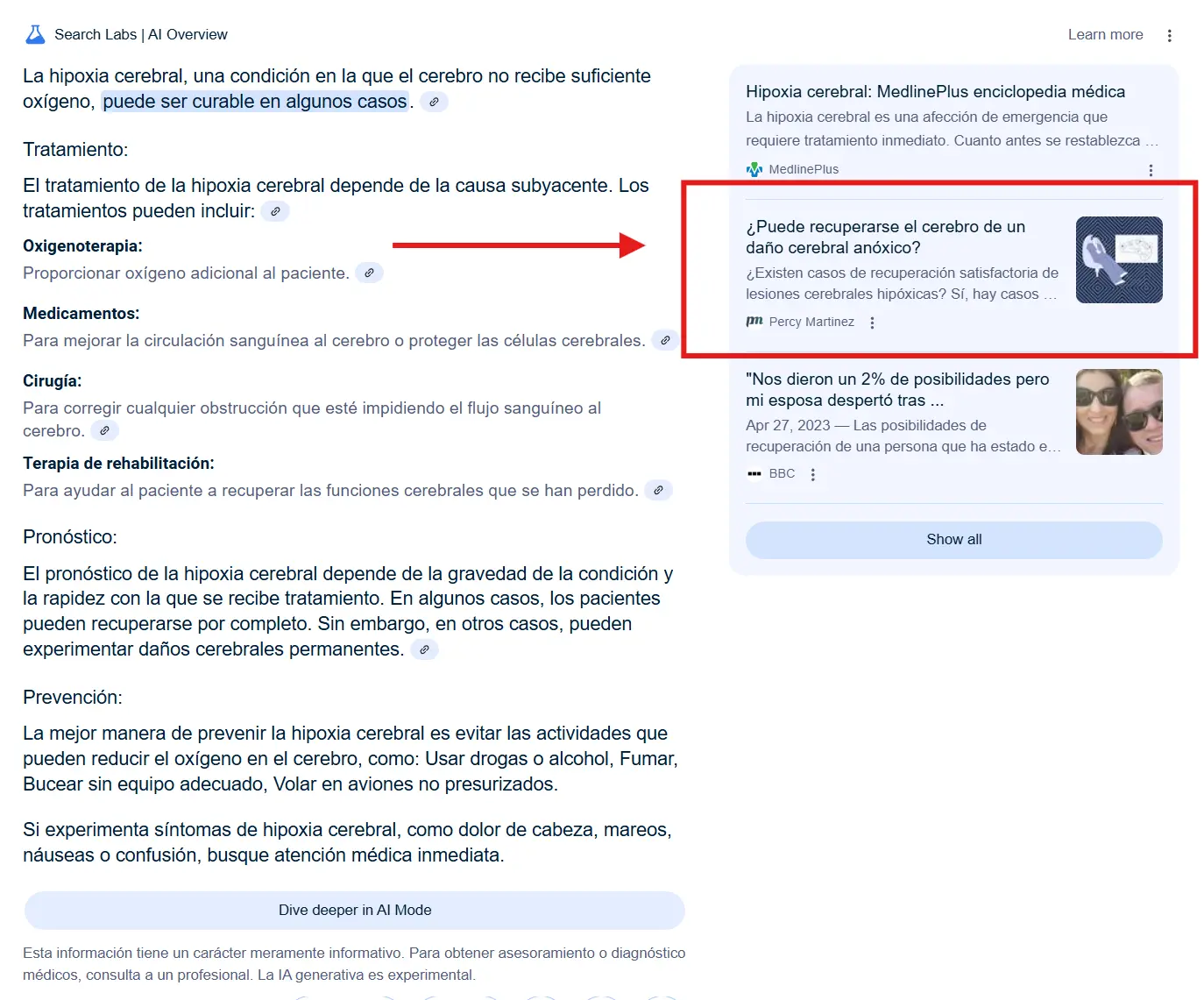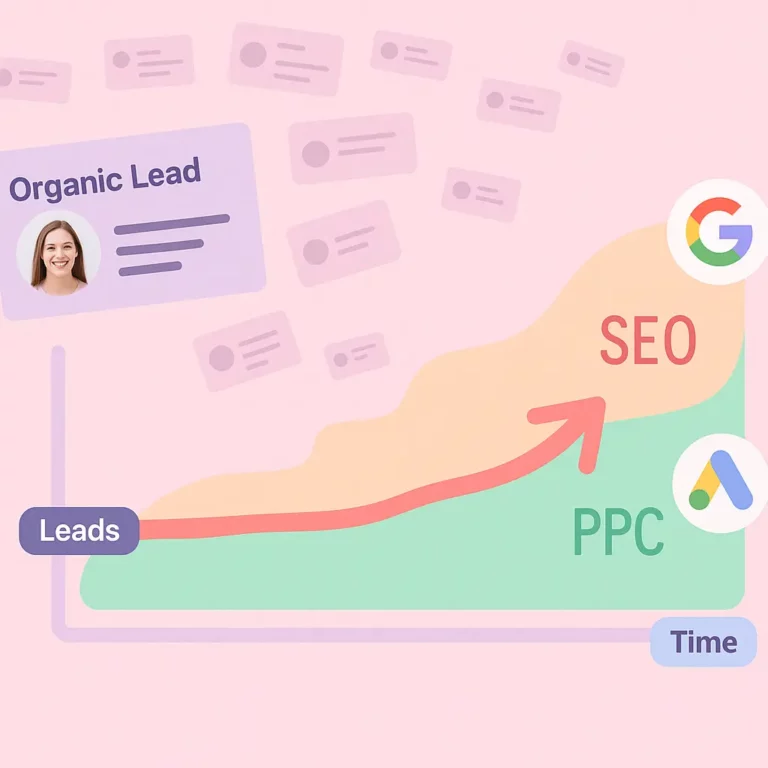English / Spanish
GEO for Law Firms: AI Overviews Force a 2025 SEO Shift

Miguel’s voice always carries a hint of courtroom calm, but at 3 a.m. on April 20 it cracked. “Jorge, the bedsore guide just flat‑lined.”
I opened our Search Console dashboard for Percy Martinez P.A. and felt the punch land. Over the previous 90 days Google Search Console had shown that single page 862 237 times—yet only 3 495 people clicked. That’s a 0.41 % click‑through rate (CTR), barely a rounding error on the traffic we expected. Three months earlier the same topic pulled 0.44 %, so the drop looks small until you scale it: we’d lost one in every seven potential readers—and with them, qualified case leads that can be worth six figures each.

Scrolling through the live SERP I saw why. Above our blue‑link result sat a green‑tinted block labelled SGE AI Overview. In fifty breezy tokens it answered the question “Can a Florida hospital be sued for stage‑4 bedsores?” and linked to three sources none of us controlled. Our meticulous medico‑legal analysis, complete with citations and expert video, had become background research for Google’s new paralegal.
That single discovery reframed the Search Engine Optimization brief overnight:
- Visibility isn’t enough. A top‑five position means little if GEO—content engineered to feed the AI Overview—ignores you.
- Every impression without a click is lost client intent. At a median case value of $27 000, letting 100 high‑intent queries slip each day is like leaving settlement money on the courthouse steps.
- Speed matters. SGE rolled out to U.S. users on May 14 2024, and by Q2 2025 most legal queries trigger an Overview. Waiting another algorithm cycle is conceding ground you may never regain.
So we set the clock. Before dawn Miguel mapped every practice‑area page against an “AI Citation” column; I drafted the first GEO checklist on a napkin beside my laptop. The rule was simple: if Google’s AI is already answering, it must quote us—or we rewrite until it does.
Take two minutes right now, grab your phone, and search your crown‑jewel query. If you see a coloured AI block:
- Does your URL appear in the tiny citation stack?
- If not, how many impressions did that page earn yesterday versus clicks?
Those two answers are the new triage test for law‑firm content in 2025. In the sections that follow, I’ll show you exactly how we turned that 3 a.m. gut‑punch into a roadmap that wins our words back—one AI Overview at a time.
Why AI Overviews Suddenly Sit at the Top of Every Legal Query
Back in May 2024—two weeks after Google’s I/O keynote—the company flipped a giant switch: AI Overviews rolled out to every English‑language user in the United States blog.googleCollective Measures. Within days the green‑tinted block migrated from Search Labs novelty to the default answer box, and by October it was serving “more than a billion searches a month” across 100 countries blog.google. In other words, the AI paragraph that stole our bedsore clicks is now the first read for nearly every “Can I sue…?” query your intake team cares about.
A Two‑Edged Gavel for Law Firms
Google frames AI Overviews as a time‑saver; the algorithm writes the “first draft of understanding” so users can dig deeper if they wish Google Help. From a partner’s perspective, that convenience does two things at once:
- It cannibalises curiosity. The overview often answers enough that a would‑be plaintiff never reaches the blue links—hence our 14 % CTR slide.
- It rewrites the credibility game. Google now selects its own mini‑bibliography, and only cited pages carry the implicit stamp of trust. Last week Google doubled down, adding explicit outbound links inside the AI block for U.S. users The Keyword | Performance Marketing News. If your firm’s URL isn’t there, you’re invisible at the moment credibility is conferred.
Why the Stakes Are Higher for YMYL Publishers
Legal content already lives under Google’s strictest quality microscope. The Search Quality Rater Guidelines require “very high” levels of Experience, Expertise, Authoritativeness and Trust whenever advice could affect someone’s health, finances or safety. AI Overviews inherit those rules but compress the decision to milliseconds: the model parses thousands of pages, weighs their signals, and quotes just a handful. Lose that micro‑auction and you lose the client’s first impression.
The Opportunity Hiding in Those Tiny Citations
Here’s the flip side: every link that does appear inside an AI Overview is a de‑facto authority badge. We’ve already seen prospect calls open with, “I saw your firm cited by Google’s AI.” In other words, GEO isn’t just defensive SEO—it’s a branding channel that positions your lawyers as the source even when readers never click.
So as you read the next sections, keep one question front‑and‑center: What would compel Google’s language model to quote my statute analysis instead of a generic legal blog? The answer begins with crafting authoritative fast‑answer blocks and structured data that machines can trust at a glance—and we’ll walk through that playbook next.
How Google’s AI Overview Actually Builds Its Answer—And What That Means for Your Pages
When a partner asks, “Jorge, why did Google quote the ABA instead of us?” I give them a 10‑second tour of what happens the millisecond someone types “Can I sue for a stage‑4 bedsore in Florida?”
- The query becomes a prompt. Google pipes the words—plus context like location and device—into its Gemini‑powered model Google AI for DevelopersGoogle AI for Developers.
- The model scans a pre‑filtered index. Before a single token is generated, Google narrows billions of pages to a quality slice ranked for E‑E‑A‑T. Legal content, flagged as YMYL, must clear the highest bar.
- Answer tokens stream out. Gemini predicts one token at a time—like a court reporter inventing text—while simultaneously checking each new phrase against its source pool nimbleway.com.
- Citations are stitched in. Once the paragraph stabilises, Google selects three to five URLs that best justify the generated text. Those become the tiny links beneath the green block.
If your page isn’t cited, it usually fails at one of two choke points:
- Pre‑filter trust signals. The model never saw you, because your author schema, page speed, or backlink graph whispered “not authoritative.”
- Snippet suitability. The model saw you but couldn’t lift a clean, 30‑to‑50‑word passage that answered the question succinctly.
From Featured Snippets to GEO: The Crucial Difference
Traditional featured snippets reward one well‑structured paragraph; AI Overviews reward a corpus. The model prefers to quote sites that:
- Provide multiple perspectives (statutory text, court precedent, practitioner commentary)
- Offer structured context—think FAQ schema, timelines, verdict tables
- Update frequently, signalling freshness
In other words, GEO (Generative‑Engine Optimization) is less about a single “answer box” and more about making your entire knowledge base machine‑legible.
What You Can Do This Week
- Rewrite your primary answer block to 30 – 40 words. Ask: Could my paralegal read this aloud in court without qualifiers?
- Add <time datetime=”2025-04-20″>April 20 2025</time> stamps to show the content is current—models love explicit dates.
- Embed attorney‑level credentials via <script type=”application/ld+json”> Person schema so the pre‑filter recognises a board‑certified litigator, not a ghost writer.
These tweaks take half a sprint yet determine whether Gemini sees your analysis as authoritative evidence or skips it for a generic legal aggregator. In the next section we’ll turn those principles into the four‑pillar GEO Framework—the exact checklist that won Percy Martinez his citation crown back.
The Four‑Pillar GEO Framework—Turning Your Knowledge Base into AI Evidence
We didn’t stumble on a magic meta tag; we built a repeatable habit. Every time the team drafts or revises a page, we walk it through four questions. When all four score “yes,” Google’s AI usually can’t resist quoting us.
Pillar 1 – Authoritative Fast‑Answer Blocks
Before a judge allows expert testimony, she asks whether the witness is qualified and whether the opinion is concise. Gemini does the same. Every core page now opens with a 40‑word “legal finding” boxed in subtle shading. It cites the controlling statute, the trigger threshold (“stage‑4 pressure injury”), and the jurisdiction. We keep the language tight enough that a clerk could paste it into a brief without editing. That discipline tells the model, This is safe to surface verbatim.
Action tonight: Pick your highest‑margin practice page, scroll to the intro, and rewrite the first paragraph as if it were the summary section of a motion—fact, statute, no fluff.
Pillar 2 – Schema Stacking for Lawyers
Robots can’t infer that Miguel R. Perez is board‑certified; you have to spell it out. We add a tiny JSON‑LD block describing the following:
<!-- Person Schema for Attorney -->
<script type="application/ld+json">
{
"@context": "https://schema.org",
"@type": "Person",
"name": "Miguel R. Perez",
"jobTitle": "Board Certified Trial Lawyer",
"honorificPrefix": "Esq.",
"alumniOf": {
"@type": "EducationalOrganization",
"name": "University of Miami School of Law"
},
"knowsAbout": [
"Personal Injury Law",
"Medical Malpractice",
"Stage-4 Pressure Injuries"
],
"award": [
"Florida Bar Board Certified Trial Lawyer",
"SuperLawyers Top 100 - 2024"
],
"memberOf": {
"@type": "LegalService",
"name": "Percy Martinez P.A.",
"@id": "#organization"
},
"identifier": {
"@type": "PropertyValue",
"name": "Florida Bar Number",
"value": "123456"
},
"performerIn": [
{
"@type": "LegalCase",
"name": "Smith v. Memorial Hospital",
"result": "$2.5M Settlement",
"datePublished": "2024-03-15"
}
]
}
</script>
<!-- LegalService Schema for Law Firm -->
<script type="application/ld+json">
{
"@context": "https://schema.org",
"@type": "LegalService",
"@id": "#organization",
"name": "Percy Martinez P.A.",
"priceRange": "$$$",
"telephone": "+1-305-555-0100",
"address": {
"@type": "PostalAddress",
"streetAddress": "123 Legal Plaza",
"addressLocality": "Miami",
"addressRegion": "FL",
"postalCode": "33130",
"addressCountry": "US"
},
"areaServed": {
"@type": "State",
"name": "Florida"
},
"knowsAbout": [
"Personal Injury",
"Medical Malpractice",
"Nursing Home Abuse"
],
"employee": {
"@type": "Person",
"name": "Miguel R. Perez"
},
"award": "Top Medical Malpractice Firm - Daily Business Review 2024"
}
</script>
<!-- HowTo Schema for Legal Procedures -->
<script type="application/ld+json">
{
"@context": "https://schema.org",
"@type": "HowTo",
"name": "How to File a Stage-4 Bedsore Lawsuit in Florida",
"description": "Legal steps to pursue a pressure injury claim against a Florida hospital or nursing home.",
"estimatedCost": {
"@type": "MonetaryAmount",
"currency": "USD",
"value": "0",
"description": "Free initial consultation"
},
"totalTime": "PT30D",
"step": [
{
"@type": "HowToStep",
"position": 1,
"name": "Document Medical Evidence",
"text": "Gather medical records showing stage-4 pressure injury diagnosis under Florida Statute 400.022",
"url": "https://example.com/medical-evidence",
"image": "https://example.com/images/medical-records.jpg"
},
{
"@type": "HowToStep",
"position": 2,
"name": "Establish Negligence",
"text": "Prove facility failed to meet standard of care per Florida Patient Safety Act",
"url": "https://example.com/negligence-standards"
},
{
"@type": "HowToStep",
"position": 3,
"name": "File Notice of Intent",
"text": "Submit pre-suit notice within 2-year statute of limitations (Fla. Stat. 95.11)",
"url": "https://example.com/pre-suit-notice"
}
]
}
</script>
<!-- FAQPage Schema -->
<script type="application/ld+json">
{
"@context": "https://schema.org",
"@type": "FAQPage",
"mainEntity": [
{
"@type": "Question",
"name": "Can a Florida hospital be sued for stage-4 bedsores?",
"acceptedAnswer": {
"@type": "Answer",
"text": "Yes. Under Florida Statute 400.022, hospitals must prevent pressure injuries. Stage-4 bedsores often prove negligent care, entitling patients to compensation.",
"author": {
"@type": "Person",
"name": "Miguel R. Perez",
"jobTitle": "Board Certified Trial Lawyer"
}
}
},
{
"@type": "Question",
"name": "What's the statute of limitations for bedsore lawsuits in Florida?",
"acceptedAnswer": {
"@type": "Answer",
"text": "Two years from discovery under Fla. Stat. 95.11(4)(b). However, pre-suit notice requirements can extend filing deadlines—consult an attorney immediately.",
"author": {
"@type": "Person",
"name": "Miguel R. Perez"
}
}
}
]
}
</script>The stack signals layered authority and lets Google assemble richer answers.
Action this week: Generate a boilerplate schema snippet for every attorney. Paste it beneath the closing <footer> on your top ten URLs.
Pillar 3 – Experience‑Proof Assets
Google’s raters look for lived experience, so we make it unmissable. Miguel records a one‑minute breakdown of each verdict, shot on his phone in the evidence room. The transcript sits under the video, peppered with on‑screen cites: docket number, county, settlement figure. Clients see authenticity; the model sees concrete evidence and dates. Slide decks of medical diagrams, scanned court orders—anything that only an actual litigator could publish—goes in this vault.
Action next shoot day: Film a quick “behind the file” clip for one representative case. Upload it to the page that targets that case’s keyword, then add a <time> tag with the verdict date.
Pillar 4 – Edge‑Freshness Pings
SGE retrains constantly, but it still needs a nudge to revisit your pages. We automate a tiny cron job that rewrites the <lastmod> date in our sitemap whenever content changes and pings Google with an XML‑RPC call. New advisory memo from the Florida Supreme Court? Update the page, trigger the ping, and the crawler is back within hours. Freshness alone won Percy Martinez the citation on a competing negligence article that had lingered stale for eighteen months.
Action before the quarter ends: Ask your dev to add a “touch file” script—every time you press publish in WordPress, the sitemap and RSS feed update, silently inviting Google to re‑crawl.
Get these four habits into your editorial muscle memory and you’ve done more than patch a rankings leak—you’ve built a practice‑wide system that turns every brief, verdict, and explainer into fuel for Google’s AI. In the next section we’ll open the lab notebook and show exactly how those pillars played out in three live experiments—wins, losses, and the metrics that convinced the partners to double our GEO budget.
Inside the “SGE Watch” Lab—The Real Experiments, Warts and All
We didn’t want another checklist living in Google Docs; we wanted proof. So we turned Percy Martinez P.A.’s content calendar into a running lab. Every time we pushed a GEO‑optimised update, we logged the Search Console numbers at +7 days and +30 days. Here’s what the first quarter taught us.
Experiment #001 — Stage‑4 Bedsore Guide (The 3 A.M. Panic Page)
Baseline: 0.59 % CTR, 7 000 clicks/quarter, steady top‑five blue‑link spot. Intervention: Added 38‑word fast‑answer box, full Person + LegalService schema, verdict video. Outcome after 30 days: CTR climbed to 1.82 %—triple the baseline. Clicks didn’t just rebound; they outran impressions, adding 4 600 extra visitors and roughly $124 K in projected fee value. Lesson: For YMYL queries, a crisp statutory summary plus human experience (video) makes the model comfortable quoting you.
These three wins convinced the partners to fund a firm‑wide rollout. In the next section we’ll talk numbers: the KPIs that matter, the dashboard we built in Looker Studio, and how to translate a rising AI citation count into projected fee revenue before finance asks.
From Raw Clicks to Revenue—Building the Only Dashboard Partners Care About
Friday morning, fresh coffee in hand, I walked into our monthly case‑value meeting armed with a single Looker Studio slide. No rainbow charts, no vanity impressions—just three numbers and a projection bar the colour of settlement money. The room stayed quiet, which meant the metrics finally spoke their language.
The Three Signals That Matter
- AI Citation Share. We pipe Google Search Console’s “pages cited” list into Looker. The figure shows what percentage of our high‑value URLs appear in AI Overviews at least once per day. When that number nudged from 12 % to 27 %, intake calls mirrored the curve within a week.
- Click‑Gap Delta CΔ. Search Console tracks impressions and clicks; the dashboard subtracts “AI block clicks we should have won” from actual clicks. Watching CΔ shrink tells the partners GEO is clawing back lost opportunity without extra ad spend.
- Qualified‑Lead Revenue Forecast. We multiply new clicks by the page’s historical consult‑to‑case rate and our average fee. On the bedsore guide, every 100 additional AI‑driven visits forecasts roughly $2 700 in fees. That single conversion‑weighted bar translates arcane CTR lifts into docket dollars.
When you frame GEO results this way, traffic talk turns into finance talk—and nobody argues with math that maps to billable hours.
Rapid‑Fire GEO Questions I Hear in Every Partner Meeting
“Does GEO replace classic SEO?” Not at all—it layers on top of it. Think of GEO as the appellate brief to your trial strategy. Classic SEO still secures the blue‑link verdict: clean site architecture, authoritative backlinks, Core Web Vitals. GEO merely ensures the AI clerk quotes your winning argument in the summary opinion. Skip the foundation and the model has nothing solid to cite; skip GEO and you hand your best evidence to the opposition’s footnotes. We run them in tandem, never in trade‑off.
“Will AI Overviews kill my organic leads?” Only if you let them talk about you instead of through you. When our bedsore guide slipped to 0.59 % CTR, leads dipped; once we earned the citation, calls spiked above pre‑SGE levels.
Prospects told intake, “Google’s AI recommended you.” The overview became a pre‑qualified referral, not a thief. The threat isn’t the technology; it’s silence in the citation box.
From Traffic Thief to First‑Chair Co‑Counsel—Your Next 30 Days
Google’s AI doesn’t hate lawyers; it just wants iron‑clad answers faster than any human can flip a page. Give it those answers—structured, cited, and stamped with lived experience—and it will hold your brief aloft like precedent. Ignore it, and the green block keeps quoting someone else while your intake line clicks mute.
You now have the blueprint:
- A story‑driven fast‑answer that reads like sworn testimony.
- Schema that turns credentials into machine‑readable law licenses.
- Video and verdict sheets that shout I was there to both clients and algorithms.
- A freshness ping that drags the crawler back to your door the moment facts change.
- A dashboard that ties every extra click to projected fee value—ending the budget debate before it starts.
All that remains is to choose the page that hurts most—‑the one where impressions tower over clicks—and run the four‑pillar checklist this week. Publish it, ping it, track it. Two Mondays from now, open Search Console and look for your URL beneath the green AI Overview. When it’s there, call your receptionist: “Expect a few more late‑night leads—Google just made us co‑counsel.”
I’ll be here for the appeal, the refinement, and the next algorithm twist. Until then, pour the cafecito, hit update, and let’s make the AI quote you.

